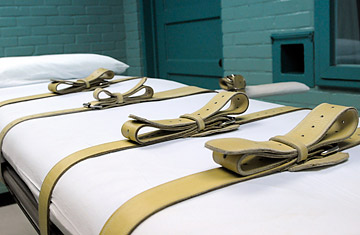
The gurney used to restrain condemned prisoners during the lethal-injection process in the death house in Huntsville, Texas
The death penalty used to be a big deal, important enough to figure prominently in the 1988 presidential debates. Four years later, in 1992, White House aspirant Bill Clinton, then governor of Arkansas, rushed home from the campaign trail to preside over an execution — because that's how politicians proved their mettle in those days.
This year's annual report of the Death Penalty Information Center (DPIC) shows how dramatically the issue has faded in recent years. Fewer death sentences were imposed in 2009 in the U.S. than in any year since capital punishment was reinstated in 1976. In the 1980s and '90s, states consistently sent more than 300 prisoners per year to death row. The total this year, according to DPIC, will be 106. This continues a steady trend going back most of the decade, and it extends even to Texas, the leading death-penalty state, where juries reliably sent 30 or more convicted killers per year to death row. That number fell to single digits this year: nine.
Many factors play a part in the fading importance of capital punishment. The drop in the number of death sentences reflects a drop in the murder rate. Many states have adopted life-without-parole terms as alternative sentencing, and both prosecutors and juries have embraced the option. Also, DPIC executive director Richard Dieter theorizes that in tough economic times, states are reluctant to take on the high costs of capital cases — the special sentencing hearings, the mandatory reviews and the nearly inevitable years of appeals. The DPIC report cites the example of California, where death sentences were up this year but none of the state's 690 death-row inmates were executed. The cash-strapped state is spending $137 million per year, according to one estimate, on its stymied death-penalty system and is making plans to build a special facility to house its enormous death-row population, at a cost of some $400 million.
There are nuggets in the report to hearten both supporters and opponents of capital punishment. The number of executions was up, after the U.S. Supreme Court cleared away a group of legal challenges to lethal injection. Fifty-two inmates were put to death in 2009 — up from 37 in 2008, but far fewer than the 98 prisoners executed in 1999. As usual, Texas put more inmates to death than any other state, with 24 executions, followed by Alabama with six and Ohio with five.
On the other hand, New Mexico became the 15th state to abolish the death penalty, with several other states coming close to taking that step.
And so it goes with the once volatile issue: urgently important to fewer and fewer people, yet less and less compelling to the country at large, the death penalty keeps sputtering along, dwindling as the years go by.
